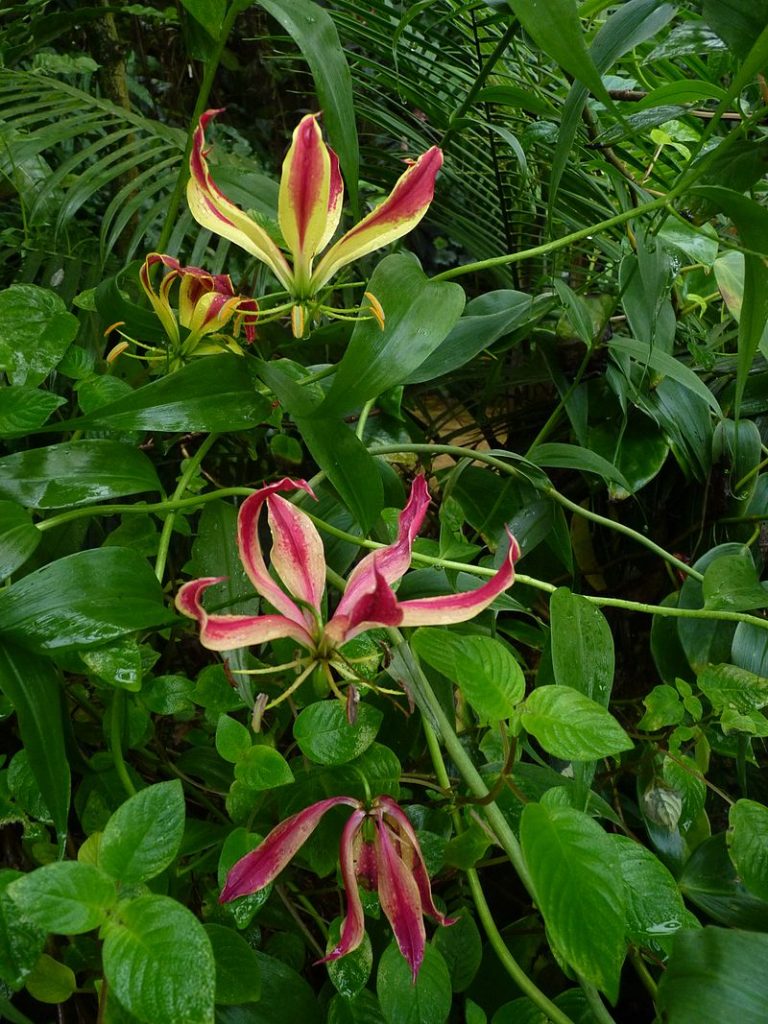
Also known as flame lily, climbing lily, creeping lily, glory lily, tiger claw, agnishikha and fire lily, this deciduous perennial vine is native to tropical and southern Africa and temperate and tropical Asia (from China to India) where it grows in a variety of habitats including jungles, forests, thickets, grasslands and sand dunes. Not a true lily, it is a member of the Colchicaceae, a small plant family that also includes autumn crocus and bellwort. The plant usually grows 1-6′ long but may reach 15′. It has a fleshy, red-brown rhizome that produces 1-4 slender stems bearing alternate or opposite, lanceolate to oval, glossy emerald green leaves. The leaves are 5-8″ long, have strong parallel veining, and are tipped with tendrils that allow the plant to climb. From mid summer to fall, cup-shaped, lily-like flowers appear in the leaf axils on stalks that are up to 7.5″ long. The flowers have 6 reflexed yellow or red tepals that are 2-3′ long, have wavy margins, and surround conspicuous stamens and style. The fleshy fruit is oblong, 2-4.5″ long, and contains about 20 rounded red seeds. All parts of the plant are considered highly toxic if ingested and the rhizomes may cause contact dermatitis. In spite of its toxicity, the plant is in great demand for medicinal uses and the plants are valued in the garden or containers for their flowers. In some areas gloriosa lily has become weedy. The genus name, Gloriosa, is the Latin word meaning glorious. The specific epithet, superba, is the Latin word meaning haughty.
Type: Deciduous, perennial vine
Bloom: Lily-like yellow to red flowers from mid summer to fall
Size: 1-15′ long x 1′ W
Light: Full sun; tolerates some shade
Soil: Humusy, moist, well-drained; tolerates low nutrient soil
Hardiness: Zones 8-12
Care: Provide a trellis for climbing; fertilize with half strength complete fertilizer twice/month; dig and store rhizomes in the fall before the first frost in climates colder than USDA hardiness zone 8
Pests and Diseases: Aphids, thrips, moths, anthracnose, viruses, bulb rot, leaf blight
Propagation: Division (no more than once every 3 years), seed (difficult)
Outstanding Selections:
‘Lutea’ (all-yellow tepals)
‘Citrina’ (yellow with red markings)
‘Grandiflora’ (large golden yellow flowers)
‘Greenii’ (creamy-green flowers)
‘Nana’ (dwarf)
‘Rothschildiana’ ( wavy-edged, strongly reflexed bright red or scarlet tepals with yellow near the base and along the margins, and bright green stamens)
Simplex’ (deep orange and yellow flowers)
‘Superba’
Photo Credit: kasparova Wikimedia Commons